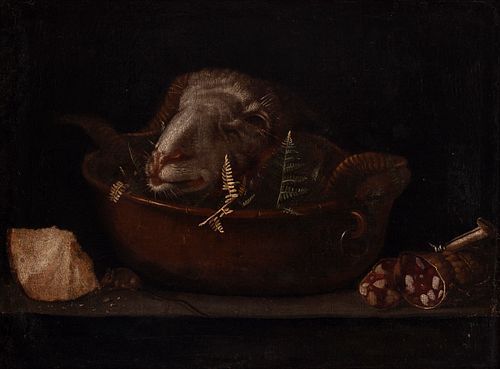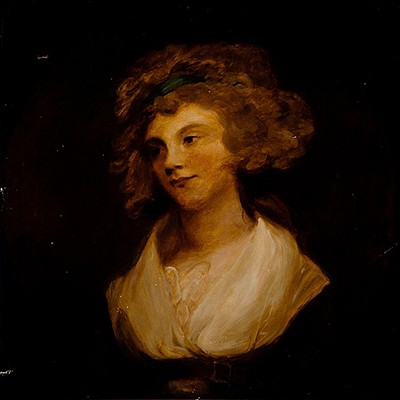Italian school; XVII century. "Still life with ram's head". Oil on canvas. Relined.
About Seller
Carrer Aragó 346
Barcelona
Spain
Setdart Subastas was born in 2004 and is currently the first online art auction in Spain with solidity, prestige and reliability guaranteed by our more than 60,000 users. Setdart has a young, dynamic and enterprising team ready to successfully manage the purchase and sale of art works through custom...Read more
Two ways to bid:
- Leave a max absentee bid and the platform will bid on your behalf up to your maximum bid during the live auction.
- Bid live during the auction and your bids will be submitted real-time to the auctioneer.
Bid Increments
| Price | Bid Increment |
|---|---|
| EUR€0 | EUR€10 |
| EUR€200 | EUR€25 |
| EUR€500 | EUR€50 |
| EUR€1,000 | EUR€100 |
| EUR€3,000 | EUR€200 |
| EUR€5,000 | EUR€500 |
| EUR€10,000 | EUR€1,000 |
| EUR€20,000 | EUR€2,000 |
| EUR€50,000 | EUR€5,000 |
About Auction
Nov 25, 2021
Setdart Auction House sofia@setdart.com
- Lot Description
Italian school; XVII century. "Still life with ram's head". Oil on canvas. Relined. It presents repainting in the painting and frame with faults in the gilding. Measurements: 48 x 64.5 cm; 64.5 x 81 cm (frame). This work faithfully follows the model of the work made by Giovanni Benedetto (Italy, 1609 - 1663/65), which belongs to the collection of the Prado Museum, although it is not currently on display. It is true that in this case the work presents a greater amplitude, and not only focuses on the clay vessel with the meat head, but also introduces several other elements, among which the mouse located in the lower left zone stands out. A Genoese painter and engraver of the Baroque period, Giovanni Benedetto Castiglione, nicknamed "the Grechetto", is now considered one of the most important draughtsmen of the 17th century. He was an absolute master in the representation of very diverse subjects, not only landscapes and bacchanals but also less orthodox scenes, even macabre ones, and he shaped his language through the most varied influences, always showing himself to be enormously receptive. Castiglione began his training in Genoa in the 1620s, where he studied the works of Bassano, Bernardo Strozzi, Rubens and Van Dyck, and trained in Paggi's workshop. In the following decade he settled in Rome, where his style shifted towards classicism through the influence of Poussin. In the Italian capital he devoted himself to the study of ancient art, which gave him a prominent position in the Genoese cultural scene when he returned to his hometown. In 1632 we find him documented as a member of the Academy of St. Luke in Rome, specializing in landscape paintings with animals. Three years later he traveled to Naples, where he became acquainted with Andrea di Lione. He then returned to Genoa, where we find him documented in 1639, already as a recognized painter. Castiglione produced from that time onwards large altarpieces and also smaller paintings of pagan and pastoral subjects for private clients. Gradually, from 1645 onwards, the master began to focus more and more on engraving. He made some monotype engravings reproducing paintings by his own hand, thus becoming a pioneer of this technique, and when he returned to Rome in 1947 he took many of his plates with him, which would be disseminated in the following years. From this period dates one of his most famous engravings, "The Rest in the Flight to Egypt", where his expertise in depicting animals and also as a religious painter is evident, treating the subject through a domestic and anecdotal point of view, perfectly framed within the taste of the Counter-Reformation. In this second Roman period Castiglione made a series of engravings following the style of Rembrant, which he knew through the plates engraved by the master between 1630 and 1640, arriving from Holland at that time.
Dimensions:
INV Number:
48 x 64.5 cm; 64.5 x 81 cm (frame).
35256453 - Shipping Info
-
In-house shipping available. Please inquire at admin@setdart.com.
-
- Buyer's Premium



 EUR
EUR CAD
CAD AUD
AUD GBP
GBP MXN
MXN HKD
HKD CNY
CNY MYR
MYR SEK
SEK SGD
SGD CHF
CHF THB
THB
















